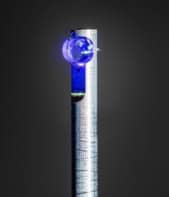
Bad metals may not be so bad after all – at least, not for theorists.
Unlike conventional metals, where electrons travel freely with few interactions and little resistance, bad metals contain electrons that move slowly and exhibit strong correlations with their neighbours. This behaviour is so atypical for metals that physicists have long regarded it as incompatible with existing theories.
Now, however, an international team led by researchers from the Vienna University of Technology in Austria have found that it may be possible to describe bad metals with conventional theories after all. This finding, based on optical spectroscopy of metallic crystals that can be made into insulators by slightly changing their chemical composition, could also advance our understanding of materials such as high-temperature superconductors, for which a complete theory is still lacking.
At the metal-to-insulator transition
Led by Andrej Pustogow, the team focused on metallic materials known as molecular charge-transfer salts. These plate-like single crystals are roughly 1 x 1 x 0.3 mm3 in size and can be grown in the laboratory using electrochemical techniques. While they typically take on the properties of a metal, if small amounts of selenium are incorporated into their structure, they become insulators. Notably, at the transition point between metal and insulator (known as the Mott transition), the crystals’ electrical resistance becomes extremely large – much larger, in fact, than should be possible according to conventional theories of metals.
Pustogow and colleagues suspected that this effect could be frequency-dependent. To test their hypothesis, they studied the material’s optical conductivity, which is the electrical conductivity in the presence of an alternating electric field. (“Optical” in this context covers the entire frequency range, not just the visible part of the electromagnetic spectrum.) In their technique, they took advantage of the fact that, in their insulating form, the crystals are transparent to infrared light over a large range of wavelengths, like glass.
When they measured how much light this bad metal reflected and transmitted at different infrared frequencies, they found that while it conducts hardly any optical current at low light frequencies, it behaves like a conventional metal at higher frequencies, conducting infrared current well.
Defects may be responsible
According to Pustogow and co-workers, low levels of defects, or impurities, in the material may be responsible for this behaviour. As the material transitions to an insulating state, the impurities are no longer adequately shielded by the metallic phase, so they start to prevent some areas of the crystal from conducting electricity. This occurs because electrons remain localized (correlated) in these areas instead of moving through the material.

‘Reluctant’ metals make a new state of matter
“Our results show that optical spectroscopy is a very important tool for answering fundamental questions in solid-state physics,” Pustogow says. “Many observations for which it was previously believed that exotic, novel models had to be developed could very well be explained by existing theories if they were adequately extended.”
The new work could also shed fresh light on the physics of high-temperature, or “unconventional”, superconductors. These materials, which are related to bad metals in that their electrons are also strongly correlated, were discovered half a century ago, but are still not fully understood.
The researchers, who report their work in Nature Communications, say they now plan to perform similar studies on “strange” metals and other materials classed as non-Fermi-liquids.



